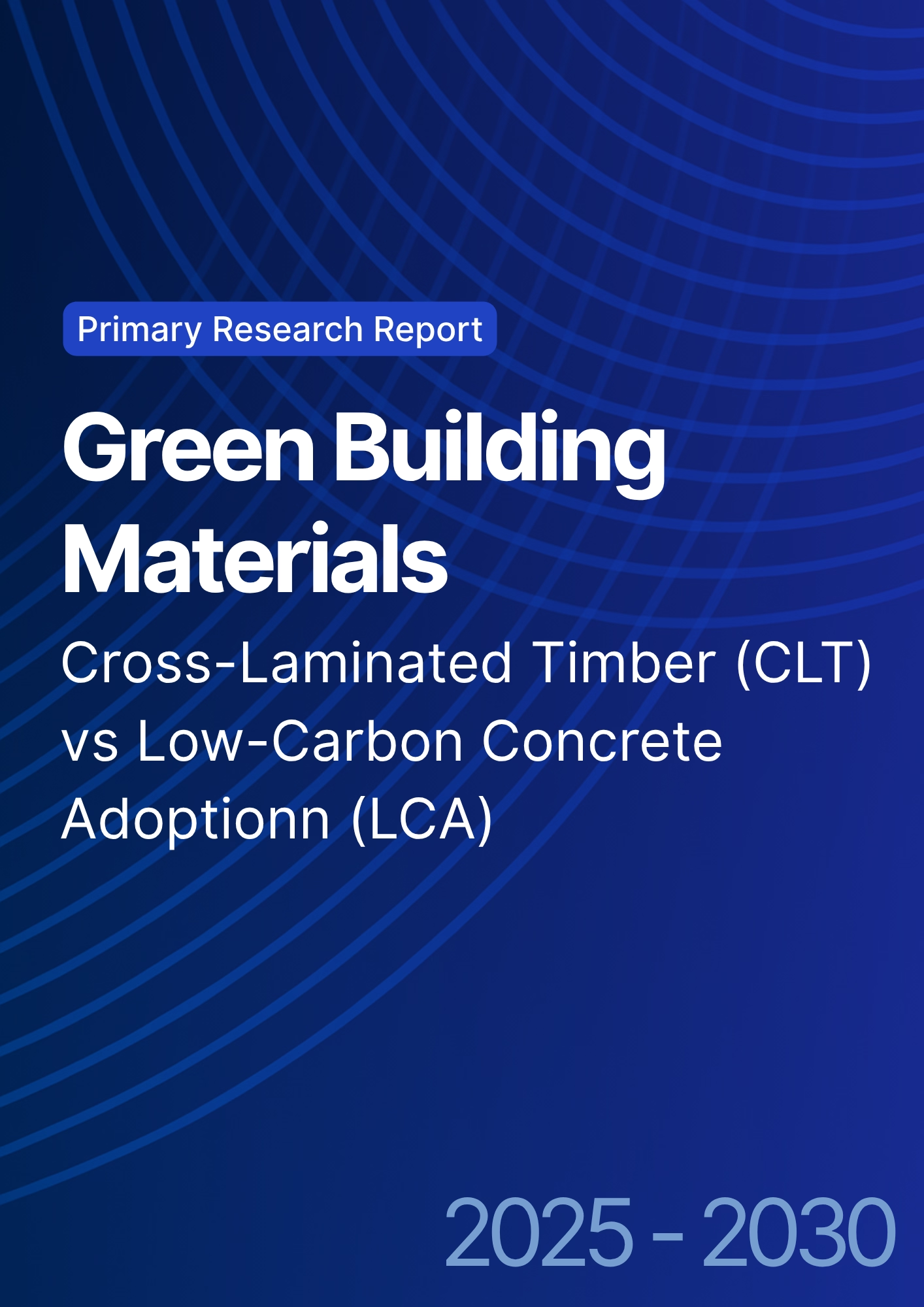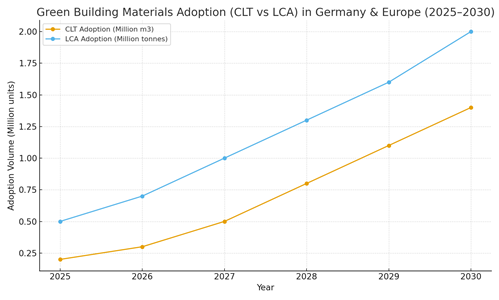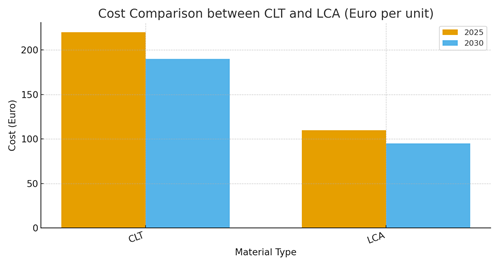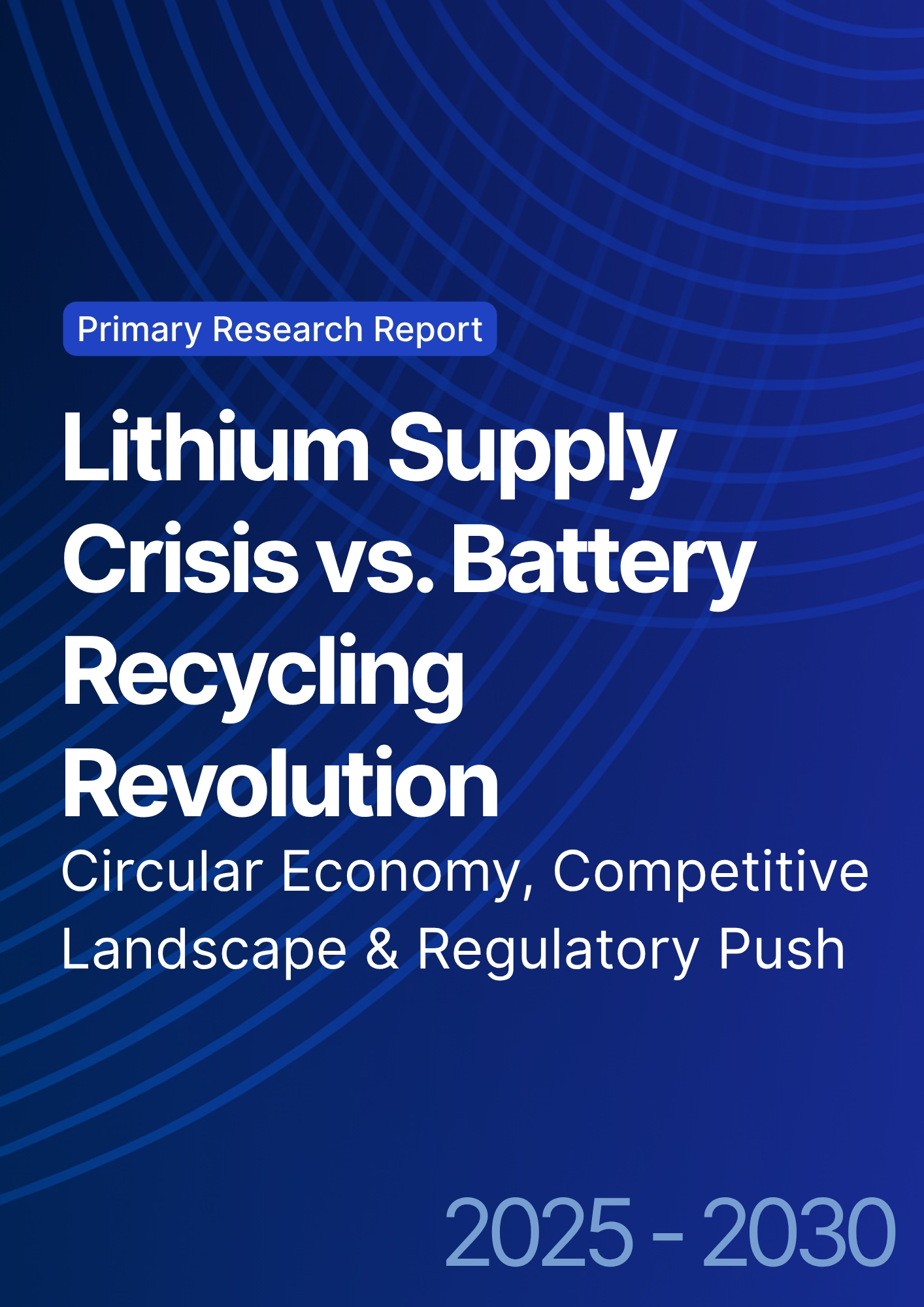

68 Circular Road, #02-01 049422, Singapore
Revenue Tower, Scbd, Jakarta 12190, Indonesia
4th Floor, Pinnacle Business Park, Andheri East, Mumbai, 400093
Cinnabar Hills, Embassy Golf Links Business Park, Bengaluru, Karnataka 560071
Connect With Us
Green Building Materials: Cross-Laminated Timber (CLT) vs Low-Carbon Concrete Adoptionn (LCA)
Green building materials are poised to play a crucial role in the decarbonization of the construction industry, particularly in Europe. As the construction industry faces growing pressure to reduce its carbon footprint, innovative building materials like cross-laminated timber (CLT) and low-carbon concrete (LCA) are gaining traction. Both materials offer significant environmental benefits compared to traditional construction materials, offering reduced carbon emissions, improved sustainability, and more efficient use of natural resources. Between 2025 and 2030, the adoption of CLT and LCA is expected to grow rapidly in Europe, with Germany leading the way. CLT is particularly well-suited for low-rise buildings, offering a renewable alternative to concrete and steel, while LCA is an ideal solution for reducing the carbon footprint of concrete structures. Adoption rates for both materials are set to rise as construction companies and governments work towards meeting increasingly stringent climate and sustainability targets.

What's Covered?
Report Summary
Key Takeaways
1) CLT and LCA are set to play a central role in decarbonizing the construction sector by 2030.
2) Germany, Sweden, and Austria will lead in CLT adoption, while France, the UK, and Italy will see significant LCA growth.
3) Both CLT and LCA will reduce the carbon intensity of construction by replacing traditional materials like concrete and steel.
4) By 2030, CLT adoption is expected to increase to 1.4 million m3 in Europe.
5) LCA adoption will reduce the carbon footprint of concrete-heavy regions, with adoption reaching 2 million tonnes by 2030.
6) CLT and LCA will help meet Europe’s carbon neutrality targets in the building sector.
7) Cost reductions in CLT and LCA will drive their widespread adoption in mainstream construction.
8) Both materials will be crucial in meeting regulatory frameworks targeting sustainability and climate goals.
Key Metrics

Market Size & Share
The market for green building materials such as Cross-Laminated Timber (CLT) and Low-Carbon Concrete (LCA) will grow significantly over the next five years. By 2030, CLT adoption in Europe is projected to reach 1.4 million m3, with Germany leading the market due to strong policy support and existing market demand. LCA adoption is expected to increase significantly, with a projected market share of 20% in the concrete industry by 2030, making it a key solution for sustainable building. The rapid adoption of CLT and LCA will be driven by both cost competitiveness and environmental regulations that target reduced carbon emissions in construction. The regulatory environment in Europe, particularly in Germany, will support this growth, with several national and EU-wide incentives and standards for sustainable construction.

Market Analysis
The cost competitiveness of CLT and LCA is improving due to economies of scale, technological advancements in production, and material innovations. By 2030, the cost of CLT is projected to decrease to EUR 190 per m3, and the cost of LCA will decrease to EUR 95 per tonne. These reductions will make both materials more affordable and accessible, driving broader adoption in the construction sector. The competitive advantages of CLT and LCA are not just in cost reduction, but also in their environmental benefits. Both materials significantly reduce carbon emissions compared to traditional building materials like concrete and steel. As sustainability becomes more important to consumers, these green materials will see increasing demand across Europe.

Trends & Insights (2025–2030)
• CLT and LCA will be pivotal in meeting Europe’s decarbonization goals for the construction industry.
• By 2030, CLT and LCA will make up a significant share of the European building materials market, especially in sustainable buildings.
• Cost reductions through economies of scale and new production methods will make both materials more accessible to mainstream construction projects.
• Germany will remain a leader in CLT and LCA adoption, with strong policies and market demand.
• LCA adoption will increase due to its cost-effectiveness and suitability for high-carbon-intensity projects like concrete structures.
• Circular economy integration will play a major role in ensuring that CLT and LCA production remains sustainable and resource-efficient.
• Standardization of CLT and LCA certifications will help ease adoption in the construction sector.
• Industry-wide collaboration will be key to scaling CLT and LCA production and adoption.
Segment Analysis
• Residential & Commercial Buildings: CLT will be used primarily in low-rise buildings, providing a renewable alternative to concrete and steel. LCA will be more prevalent in high-rise buildings and larger concrete-intensive projects.
• Infrastructure & Public Buildings: LCA adoption will grow in government-funded projects, where sustainability goals are a priority.
• Industrial Applications: Both CLT and LCA will find use in industrial settings, where structural integrity and sustainability are key factors.
• Developers & Builders: Construction companies will be incentivized to use CLT and LCA as part of their sustainability initiatives, with government incentives for green building certifications.
• Manufacturers: CLT and LCA manufacturers will expand their operations, driven by growing demand and technological improvements in production.
Geography Analysis (Germany & Europe)
Germany and the Nordic countries will be at the forefront of CLT and LCA adoption due to strong policies supporting sustainable construction. Other European countries, such as France, the UK, and Austria, will follow suit, adopting these materials in their building sectors. Belgium, Sweden, and Norway will also see significant growth in CLT and LCA adoption. The EU’s push for sustainability and carbon reduction will further support the growth of green building materials. France and Spain are expected to increase their adoption of LCA, while Italy will focus on CLT for low-rise buildings and residential projects.

Competitive Landscape (Ecosystem & Delivery Models)
The competitive landscape for CLT and LCA is evolving as more manufacturers scale production. Key players in the CLT sector include companies like Stora Enso, Binderholz, and KLH, while LCA adoption will involve major cement manufacturers like Heidelberg Cement and Lafarge Holcim, who are leading the development of low-carbon concrete alternatives. Collaboration between manufacturers, policymakers, and construction firms will be essential to scaling both CLT and LCA production and ensuring that they meet the necessary standards for use in construction projects. The market will also see an increasing number of partnerships focused on integrating green building materials into mainstream construction projects.
Report Details
Proceed To Buy
Want a More Customized Experience?
- Request a Customized Transcript: Submit your own questions or specify changes. We’ll conduct a new call with the industry expert, covering both the original and your additional questions. You’ll receive an updated report for a small fee over the standard price.
- Request a Direct Call with the Expert: If you prefer a live conversation, we can facilitate a call between you and the expert. After the call, you’ll get the full recording, a verbatim transcript, and continued platform access to query the content and more.


68 Circular Road, #02-01 049422, Singapore
Revenue Tower, Scbd, Jakarta 12190, Indonesia
4th Floor, Pinnacle Business Park, Andheri East, Mumbai, 400093
Cinnabar Hills, Embassy Golf Links Business Park, Bengaluru, Karnataka 560071
Request Custom Transcript
Related Transcripts
$ 1445


68 Circular Road, #02-01 049422, Singapore
Revenue Tower, Scbd, Jakarta 12190, Indonesia
4th Floor, Pinnacle Business Park, Andheri East, Mumbai, 400093
Cinnabar Hills, Embassy Golf Links Business Park, Bengaluru, Karnataka 560071













